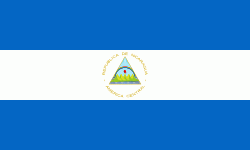Camoapa (Municipio de Camoapa)
Camoapa is a city and a municipality in the Boaco department of Nicaragua.
Camoapa city is the capital of a municipality described within the Boaco departmental area of Nicaragua. Although Camoapa is a small town, (founded on August 23, 1858), on March 2, 1926, (more than eighty years ago), the status of Camoapa was raised to the title of city. Camoapa Municipality has a population of 39,865 (2021 estimate). Its territory extension, an area of 1,483 km² varies slightly and on average is about 540m above sea level. Camoapa is located 114 km. from Managua.
The population of Camoapa is predominantly rural, 56.6% living in rural areas versus 43.4% living in urban areas.
Camoapa is the largest cattle producing region in Nicaragua. The economy of Camoapa is based primarily on agriculture and the cattle industry, (cattle raising, trading and dairy). Other local industries include leather handcrafting and the crafting of "sombreros de pita", hand woven hats.
Religion; The population is mostly Catholic, and the Protestant religion is popular as well. While primarily Christian in practice, religious practices in Camoapa can vary.
One of the most important festivals is held on June 24 in honor of the Sacred Heart of Jesus. In addition, on October 4, Camoapa celebrates with a big festival to honor the city's patron St. Francis of Assisi. Included among the numerous festivals celebrated during holidays in Camoapa, festivities also include La purisima, (a national holiday), and the National Cattle fair celebrated in April.
Local entertainment includes a bar and nightclub scene where dance halls and discothèques are popular. rodeos which feature bull riding are very popular. Rodeos are very popular as a primary economic activity in Camoapa is Cattle ranching. cock fighting tournaments are popular as well.
Camoapa city is the capital of a municipality described within the Boaco departmental area of Nicaragua. Although Camoapa is a small town, (founded on August 23, 1858), on March 2, 1926, (more than eighty years ago), the status of Camoapa was raised to the title of city. Camoapa Municipality has a population of 39,865 (2021 estimate). Its territory extension, an area of 1,483 km² varies slightly and on average is about 540m above sea level. Camoapa is located 114 km. from Managua.
The population of Camoapa is predominantly rural, 56.6% living in rural areas versus 43.4% living in urban areas.
Camoapa is the largest cattle producing region in Nicaragua. The economy of Camoapa is based primarily on agriculture and the cattle industry, (cattle raising, trading and dairy). Other local industries include leather handcrafting and the crafting of "sombreros de pita", hand woven hats.
Religion; The population is mostly Catholic, and the Protestant religion is popular as well. While primarily Christian in practice, religious practices in Camoapa can vary.
One of the most important festivals is held on June 24 in honor of the Sacred Heart of Jesus. In addition, on October 4, Camoapa celebrates with a big festival to honor the city's patron St. Francis of Assisi. Included among the numerous festivals celebrated during holidays in Camoapa, festivities also include La purisima, (a national holiday), and the National Cattle fair celebrated in April.
Local entertainment includes a bar and nightclub scene where dance halls and discothèques are popular. rodeos which feature bull riding are very popular. Rodeos are very popular as a primary economic activity in Camoapa is Cattle ranching. cock fighting tournaments are popular as well.
Map - Camoapa (Municipio de Camoapa)
Map
Country - Nicaragua
 |
 |
| Flag of Nicaragua | |
Originally inhabited by various indigenous cultures since ancient times, the region was conquered by the Spanish Empire in the 16th century. Nicaragua gained independence from Spain in 1821. The Mosquito Coast followed a different historical path, being colonized by the English in the 17th century and later coming under British rule. It became an autonomous territory of Nicaragua in 1860 and its northernmost part was transferred to Honduras in 1960. Since its independence, Nicaragua has undergone periods of political unrest, dictatorship, occupation and fiscal crisis, including the Nicaraguan Revolution of the 1960s and 1970s and the Contra War of the 1980s.
Currency / Language
| ISO | Currency | Symbol | Significant figures |
|---|---|---|---|
| NIO | Nicaraguan córdoba | C$ | 2 |
| ISO | Language |
|---|---|
| EN | English language |
| ES | Spanish language |















